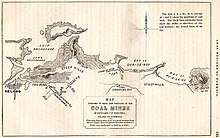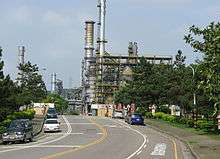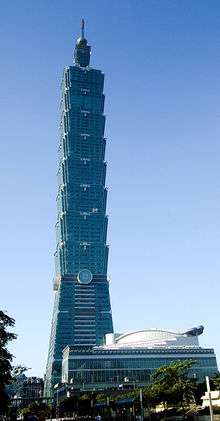Mining in Taiwan
Mining in Taiwan was once a great industry, especially for sulfur, clay, gold and coal. Nowadays, Taiwan lacks natural resources for mining and relies on imports to meet its demand for minerals. The current mining industries in Taiwan are of small and medium size in terms of exploited minerals and the scale of mining, mainly focusing on marble and limestone for cement, stone and craft industries and sand and gravel for construction industries.[1] Mining activities in Taiwan are regulated by the Bureau of Mines of the Ministry of Economic Affairs.
History of mining

Pre-colonization the indigenous people of Taiwan traded sulfur from deposits around volcanic vents to Chinese merchants visiting from the continent.[2]
Chinese mining and metallurgy followed the Hoklo, Hakka, and Han to Taiwan Island, particularly after the late Ming (16th & 17th centuries). Work was expanded under the Qing, but was limited by the occupation of the highlands by hostile native peoples.
Under the consent of the Fujian officials, Yu Yonghe travelled to Taiwan following the explosion of the Fuzhou gunpowder stores in 1696 to mine sulfur. Yu's voyage began at the coast to Xiamen, crossing the Taiwan Strait and coming to a halt in Penghu before arriving in Tainan. Yu then journeyed northward to Tamsui and Beitou where he bought amorphous sulfur from local Aborigines for the making of pure sulfur. The expedition lasted ten months. This trip became the basis of one of the most important works about early Qing-era Taiwan, Small Sea Travel Diaries (裨海紀遊).[3]
As late as 1880, the only resources known to exist in economical quantities and locations were coal, sulphur, and petroleum,[4] all in the volcanic northeastern third of the island. Mining was progressively developed by both the government and private sectors.[5]
After "Taiwan" (i.e. Tainan) and "Taashwi" (i.e. Tamsui) were opened to foreign commerce by the 1858 Treaties of Tianjin,[6][7] foreign ships required those ports to maintain supplies of coal. This was provided from fields near Keelung and Tamsui, whose highly bituminous coal was fast-burning but nonetheless used by the warships of the Fuzhou Arsenal.[4] The high demand led to rampant smuggling and theft, to the point where the Qing government temporarily banned the trade to rein in its ill effects.[4] The Qing introduced modern coal mining to Taiwan in 1877, when they retained the British engineer Tyzack to open a 91 m (300 ft) shaft with modern machinery.[4]
Taiwan's heavy industry was developed by Japan both before and during the Second World War, but US bombing—particularly after the Taiwan Air Battle in October 1944 gave the Americans air supremacy—devastated mining production. Although overall industry had declined only 33% from 1937 levels by the war's end, coal production had fallen from 200,000 metric tons (197,000 long tons; 220,000 short tons) to 15,000 metric tons (14,800 long tons; 16,500 short tons),[8] lower than the amount produced in the mid-1870s.[4]
Economy
As of 2013, mineral products accounted for 10% of Taiwan export value. The sector also employs 2,758 workforce.[9]
Types of mining
Aluminium
Taiwan consumed about 180,000 tonnes of aluminium alloy in 2013, in which it went to the electronics sector (41%), packing (26%), construction (9%), machinery (8%) and others (16%). The CS Aluminium Corp., subsidiary of China Steel Corporation, produced 167,000 tonnes of aluminium in 2010.[9]
Cement

Around 80% of Taiwan's cement are mined and produced in Eastern Taiwan. In 2013, the output capacity was 26 million tonnes per year. In that year, Taiwan produced 16 Mt of cement and consumed 12 Mt. Cement are exported to Ghana, Malaysia, Indonesia, Mauritius and Australia.[9] Cement mining in Taiwan is mostly done by Taiwan Cement or Asia Cement Corporation in which its plant in Hualien County contributes to nearly 29% of Taiwan's cement production.[10]
Limestone mining was done in Zuoying District, Kaohsiung in an area what used to be a part of Mount Banping. In 1997, the mining activities ceased to operate. The abandoned site has now been turned into the Banping Lake Wetland Park for tourism by the Kaohsiung City Government.[11]
Coal
Coal is distributed mainly in northern Taiwan. All of the commercial coal deposits occurred in three Miocene coal-bearing formations, which are the Upper, the Middle and the Lower Coal Measures. The Middle Coal Measures was the most important with its wide distribution, great number of coal beds and extensive potential reserves. Taiwan has coal reserves estimated to be 100-180 Mt. However, coal output had been small, amounting to 6,948 metric tonnes per month from 4 pits before it ceased production effectively in 2000.[12] The abandoned coal mine in Pingxi District, New Taipei has now been turned into the Taiwan Coal Mine Museum, while the one in Houtong has been turned into Houtong Cat Village.[13]
Copper
Copper mining, as well as gold, used to take place in Jinguashi town in Ruifang District, New Taipei. In 1904, arsenic-copper sulfate mineral enargite was found at the No. 3 Mine in the area when miners dug deeper, increasing the amount of copper minerals discovered. From that moment, the focus of the mining in the area shifted from gold and silver to gold, silver and copper. After the liberation of Taiwan in 1945, the state-run Taiwan Gold and Copper Mining Bureau was established in 1946 and renamed to Taiwan Metals Mining Company in 1955. As copper production gradually increased over the years, Jinguashi mining area maintained excellent operating performance. However, after 1973, the gold and copper output began to decline. In order to increase the production, the company started large-scale open-pit mining in 1978 and shifted its focus to mineral refining and processing. To boost their mineral processing capabilities, the company took out bank loans in 1981 to build the Lile Copper Refinery in the area located at the Golden Waterfall today. Because of a collapse in the world copper price few years later, the company was unable to repay its loans and went out of business in 1987. The Taiwan Sugar Corporation assumed ownership of the land in Jinguashi and the mining in that area came to an end.[14]
Gold
Taiwan has four gold-bearing deposits with metal content estimated at 100 tonnes. Three of the deposits are concentrated in the central mountain range, while the fourth one is at Pingfeng Mountain in the north. Jinguashi Mine is one of the biggest gold deposit, located in Ruifang District, New Taipei. The Gold Ecological Park was established within the area which houses the Gold Museum. Quartz was often found at the same rate as gold.
Oil and gas

Oil was firstly discovered in Taiwan in Gongguan Township, Miaoli County at the Chuhuangkeng oilfield. Oil has been drilled since the Qing Dynasty rule of Taiwan in 1877. It was then done by the more advanced development stage by the Japanese when they drilled around 98 oil wells. The original site of the first oil well in Taiwan has now turned into the Taiwan Oil Field Exhibition Hall.[15] Oil exploration in Taiwan is controlled by the CPC Corporation. Deep drilling in Taiwan began in 1959 when the CPC drilled to a depth up to 4,063 meters which they brought out more than 110,000 m3 of natural gas and 10,000 liters condensate daily. Offshore drilling began in 1973 when their rig went down 3,661 meters under the ocean off the coast of Hsinchu County with no result.[16] In January 2013, Taiwan had 2 million barrels of proven oil reserves.[17] In 2012, Taiwan produced 22,000 barrels/day of oil. In 2007, the capacity of Taiwan oil refinery was 1,197,000 barrels/day due to its large refinery sectors.[18] In 2012, Taiwan planned to explore oil offshore of Taiping Island in Cijin District, Kaohsiung City.[19]
Taiwan produces a small amount of natural gas. Gas exploration in Taiwan is also controlled by the CPC Corporation. It also cooperates with China National Offshore Oil Corporation in exploring natural gas in the Taiwan Strait.[17] In 2004, natural reserved was discovered in Guantian Township, Tainan County. In July 2010, the CPC discovered natural gas reserves in Gongguan Township, Miaoli County which was estimated to have a production capacity of at least 1 billion m3.[20] In March 2013, Taiwanese oceanic research team discovered gas hydrate deposits in water south of Pratas Islands, Kaohsiung City in the South China Sea through reflection seismology and sub-bottom profiling data.[21]
Energy usage
In 2014, mining sector consumed a total of 474.4 GWh of electricity.[12]
Tourism
Sites for mining-related tourism in Taiwan include:
See also
References
Citations
- "Mining in Taiwan (ROC) - Overview". Mbendi.com. Archived from the original on 2013-07-13. Retrieved 2014-05-26.
- "The Mountains of North Taiwan". topics.amcham.com.tw. Topics. Retrieved 12 May 2020.
- http://www.taipeitimes.com/News/feat/archives/2003/03/16/198332
- EB (1879), p. 416.
- "Westernized Mining - 台灣大百科全書 Encyclopedia of Taiwan". Taiwanpedia.culture.tw. 2014-03-11. Archived from the original on 2014-05-28. Retrieved 2014-05-26.
- Russian Treaty of Tianjin (1858), Art. 3.
- French Treaty of Tianjin (1858), Art. 6.
- "歷史與發展 (History and Development)". Taipower Corporation. Archived from the original on 2007-05-14. Retrieved 2006-08-06.
- "Taiwan [advance release]" (PDF). 2013 Minerals Yearbook. U.S. Geological Survey.
- Kuo, Chia-erh (13 June 2017). "Asia Cement denies mine site in Hualien expanded". Taipei Times. Retrieved 13 June 2017.
- "A Symphony of Water and Green-Towards a Rebirth of Caogong Canal and a New Fragrant Waterfront Kaohsiung". Library.taiwanschoolnet.org. Retrieved 2014-05-28.
- "Energy Statistical annual Reports". Bureau of Energy, Ministry of Economic Affairs.
- "Coal Mining in Taiwan (ROC) - Overview". Mbendi.com. Archived from the original on 2015-10-17. Retrieved 2014-05-26.
- "Historical background". Taiwan.gov.tw. Archived from the original on 2014-05-27. Retrieved 2014-05-27.
- "Culture and Tourism Buresu of Miaoli - Taiwan Oil Field Exhibition Hall". Miaolitravel.net. 2012-12-20. Archived from the original on 2013-11-18. Retrieved 2014-05-26.
- "ROC still digging hard to find more oil, gas". Taiwan Info. 4 October 1981. Archived from the original on 6 October 2014.
- "U.S. Energy Information Administration (EIA)". eia.gov. Retrieved 2014-08-23.
- "Oil and Gas in Taiwan (ROC) - Overview". mbendi.com. Archived from the original on 2014-06-10. Retrieved 2014-08-23.
- "Taiwan to start oil exploration in S China Sea". Taipei Times. 2014-05-20. Retrieved 2014-05-26.
- Chen, Kevin (30 July 2010). "CPC Corp, Taiwan finds gas reserves at old Miaoli well". Taipei Times.
- "Taiwan finds gas hydrates deposts in South China Sea". naturalgasasia.com. Retrieved 2014-08-23.
Bibliography
- , Encyclopaedia Britannica, 9th ed., Vol. IX, New York: Charles Scribner's Sons, 1879, pp. 415–17.
- Gros, Jean-Baptiste-Louis; et al. (27 June 1858), "Traité de Tien-Tsin", Tianjin. (in French)
- Putyatin, Yevfimiy; et al. (13 June 1858), "Трактат между Россией и Китаем об Определении Взаимных Отношений", Tianjin. (in Russian)
| Wikimedia Commons has media related to Mining in Taiwan. |


